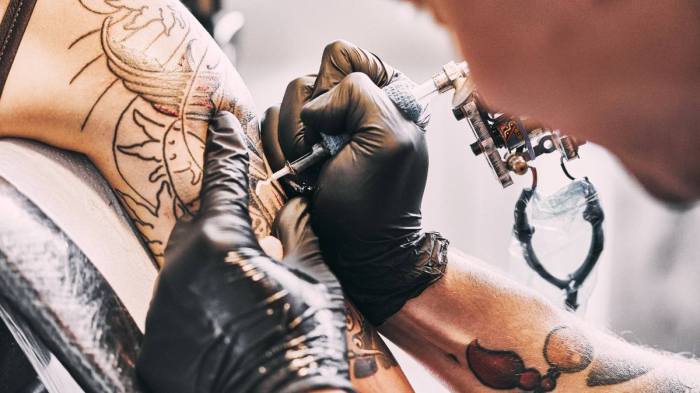Body art facility infection prevention and control plan guideline answers: delve into the intricacies of maintaining a hygienic and safe environment in body art facilities. This comprehensive guide provides essential insights into the key elements, environmental control measures, sterilization and disinfection techniques, training and education strategies, and monitoring and evaluation processes involved in infection prevention and control within body art settings.
Ensuring the well-being of both clients and practitioners in body art facilities necessitates a meticulous approach to infection prevention and control. This guideline serves as an indispensable resource for establishing and implementing effective infection control practices, empowering body art professionals with the knowledge and tools to safeguard the health and safety of all individuals involved.
Introduction

Body art facility infection prevention and control plan (IPC plan) is a comprehensive document that Artikels the policies and procedures for preventing and controlling infections in body art facilities. It is essential for protecting both clients and staff from the transmission of infectious diseases.
Infection prevention and control in body art facilities is critical for several reasons. First, body art procedures involve breaking the skin, which creates a potential entry point for pathogens. Second, body art facilities are often frequented by individuals who may be at increased risk for infection, such as those with compromised immune systems or chronic health conditions.
Third, body art facilities can be a breeding ground for bacteria and other microorganisms if proper cleaning and disinfection practices are not followed.
Infection Prevention and Control Elements
An effective IPC plan for body art facilities should include the following key elements:
- Standard precautions: Standard precautions are a set of infection control practices that are used to prevent the transmission of bloodborne and other infectious diseases. These precautions include wearing gloves, gowns, and masks, and washing hands frequently.
- Hand hygiene: Hand hygiene is one of the most important infection prevention and control measures. Hands should be washed frequently with soap and water or an alcohol-based hand sanitizer.
- Personal protective equipment (PPE): PPE is worn to protect staff from exposure to bloodborne and other infectious diseases. PPE includes gloves, gowns, masks, and eye protection.
Environmental Control, Body art facility infection prevention and control plan guideline answers
Maintaining a clean and hygienic environment is essential for preventing infections in body art facilities. This includes:
- Regular cleaning and disinfection of surfaces: All surfaces in the facility, including work surfaces, equipment, and floors, should be cleaned and disinfected regularly with an EPA-registered disinfectant.
- Proper waste management: All waste, including sharps, blood, and other bodily fluids, should be disposed of in accordance with local regulations.
- Air quality control: The air in the facility should be well-ventilated to prevent the accumulation of airborne contaminants.
Sterilization and Disinfection
Sterilization and disinfection are essential for preventing the transmission of infections in body art facilities. Sterilization is the process of killing all microorganisms on an object, while disinfection is the process of killing most microorganisms on an object. Instruments and equipment used in body art procedures should be sterilized or disinfected before each use.
There are a variety of methods that can be used to sterilize and disinfect instruments and equipment. These methods include:
- Autoclaving: Autoclaving is a process that uses steam under pressure to sterilize instruments and equipment.
- Chemical sterilization: Chemical sterilization is a process that uses a chemical solution to sterilize instruments and equipment.
- Disinfection: Disinfection is a process that uses a chemical solution to kill most microorganisms on an object.
Training and Education
Training and education are essential for ensuring that staff in body art facilities are able to implement infection prevention and control practices effectively. Staff should be trained on the following topics:
- Standard precautions
- Hand hygiene
- PPE
- Environmental control
- Sterilization and disinfection
Monitoring and Evaluation
Ongoing monitoring and evaluation are essential for ensuring that infection prevention and control practices are being implemented effectively. This includes:
- Regular audits of the facility to ensure that all infection prevention and control practices are being followed.
- Review of infection rates to identify any trends or areas for improvement.
- Staff feedback to identify any challenges or areas for improvement.
Key Questions Answered: Body Art Facility Infection Prevention And Control Plan Guideline Answers
What is the primary objective of an infection prevention and control plan in a body art facility?
To establish and maintain a safe and hygienic environment that minimizes the risk of infections for both clients and practitioners.
What are the key elements of an effective infection prevention and control plan?
Standard precautions, hand hygiene, personal protective equipment (PPE), environmental control, sterilization and disinfection, training and education, and monitoring and evaluation.
Why is environmental control crucial in body art facilities?
To prevent the spread of microorganisms through surfaces, air, and waste, ensuring a clean and hygienic environment for body art procedures.
What are the essential principles of sterilization and disinfection in body art settings?
Eliminating or reducing microorganisms on instruments and equipment to prevent the transmission of infections.
How does training and education contribute to infection prevention and control?
By equipping staff with the knowledge and skills to implement and maintain effective infection control practices.